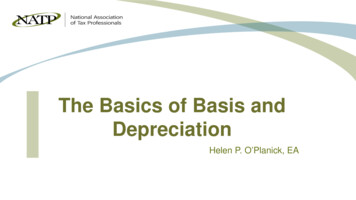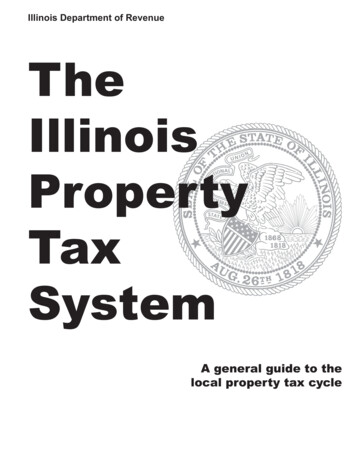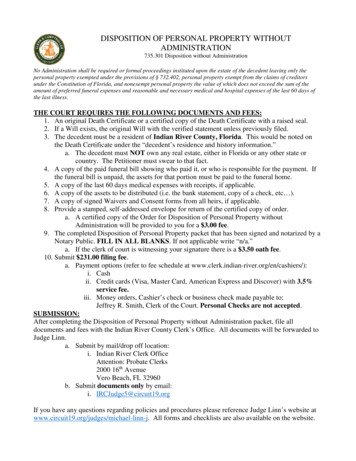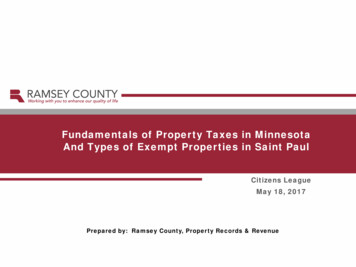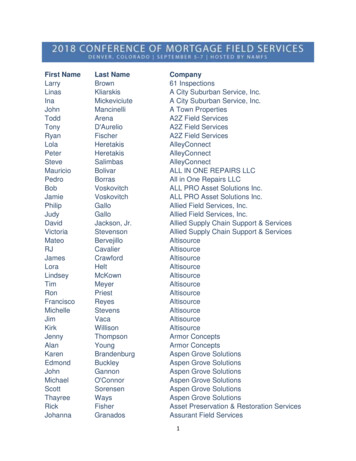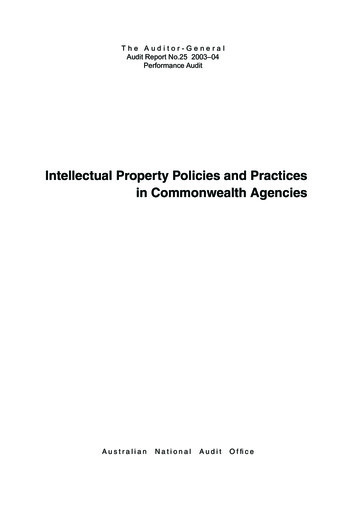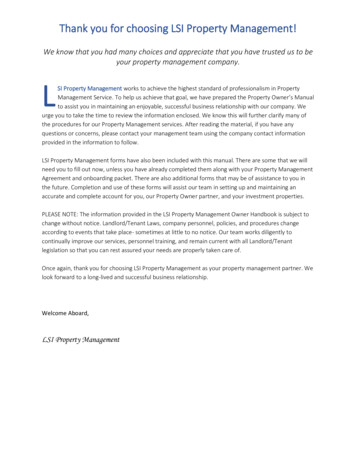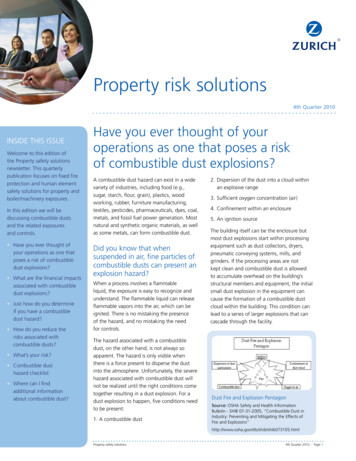
Transcription
Property risk solutions4th Quarter 2010Inside this issueWelcome to this edition ofthe Property safety solutionsnewsletter. This quarterlypublication focuses on fixed fireprotection and human elementsafety solutions for property andboiler/machinery exposures.In this edition we will bediscussing combustible dustsand the related exposuresand controls. Have you ever thought ofyour operations as one thatposes a risk of combustibledust explosions? What are the financial impactsassociated with combustibledust explosions? Just how do you determineif you have a combustibledust hazard? How do you reduce therisks associated withcombustible dusts? What’s your risk? Combustible dusthazard checklist Where can I findadditional informationabout combustible dust?Have you ever thought of youroperations as one that poses a riskof combustible dust explosions?A combustible dust hazard can exist in a widevariety of industries, including food (e.g.,sugar, starch, flour, grain), plastics, woodworking, rubber, furniture manufacturing,textiles, pesticides, pharmaceuticals, dyes, coal,metals, and fossil fuel power generation. Mostnatural and synthetic organic materials, as wellas some metals, can form combustible dust.Did you know that whensuspended in air, fine particles ofcombustible dusts can present anexplosion hazard?When a process involves a flammableliquid, the exposure is easy to recognize andunderstand. The flammable liquid can releaseflammable vapors into the air, which can beignited. There is no mistaking the presenceof the hazard, and no mistaking the needfor controls.The hazard associated with a combustibledust, on the other hand, is not always soapparent. The hazard is only visible whenthere is a force present to disperse the dustinto the atmosphere. Unfortunately, the severehazard associated with combustible dust willnot be realized until the right conditions cometogether resulting in a dust explosion. For adust explosion to happen, five conditions needto be present:1. A combustible dust2. Dispersion of the dust into a cloud withinan explosive range3. Sufficient oxygen concentration (air)4. Confinement within an enclosure5. An ignition sourceThe building itself can be the enclosure butmost dust explosions start within processingequipment such as dust collectors, dryers,pneumatic conveying systems, mills, andgrinders. If the processing areas are notkept clean and combustible dust is allowedto accumulate overhead on the building’sstructural members and equipment, the initialsmall dust explosion in the equipment cancause the formation of a combustible dustcloud within the building. This condition canlead to a series of larger explosions that cancascade through the facility.Dust Fire and Explosion PentagonSource: OSHA Safety and Health InformationBulletin - SHIB 07-31-2005, “Combustible Dust inIndustry: Preventing and Mitigating the Effects ofFire and 05.htmlProperty safety solutions4th Quarter 2010 Page 1
Applicable NFPAStandards NFPA 61: “Standard for thePrevention of Fires and DustExplosions in Agricultural andFood Processing Facilities” NFPA 68: “Standard onExplosion Protection byDeflagration Venting” NFPA 69: “Standard onExplosion Prevention Systems” NFPA 70: “NationalElectrical Code” NFPA 499: “Classificationof Combustible Dusts andof Hazardous (Classified)Locations for ElectricalInstallations in ChemicalProcess Areas” NFPA 654: “Standard forthe Prevention of Fire andDust Explosions from theManufacturing, Processing,and Handling of CombustibleParticulate Solids” NFPA 664: “Standard forthe Prevention of Fires andExplosions in Wood Processingand Woodworking FacilitiesWhat are the financialimpacts associated withcombustible dust explosions?More than 150 combustible-dust related firesand explosions occurred in the US in 2008,according to research carried out by theCombustible Dust Policy Institute. These dustexplosions almost always lead to financial lossesin terms of damaged facilities, equipment downtime and employee injury. The direct costsassociated with a dust explosion can easilyexceed the million dollar mark, with some of themore catastrophic explosions reaching rangeswell into the hundreds of millions of dollars.Some of the direct and indirect costs associatedwith an explosion can include, but are notlimited to: Potential for injury or death Entire plant rebuild or shutdown Equipment replacement Process restructuring Production downtime Supply chain disruptions Market share decline Loss revenue and profits Regulatory fines (OSHA, EPA) LitigationJust how do you determine if youhave a combustible dust hazard?A starting point is to evaluate thematerials being processed or handled.Consider both the type and formA heightened awarenessof the material. If the materialis organic, carbonaceous, orof combustible dusts hazardsmetallic and handled in aalong with a goodfinely divided form such as aunderstanding of the hazarddust or powder, then there iscontrols is the first step inreason for possible concern.Examples of combustible dust sourcesOrganic, naturalAgricultural grains, sugar, woodOrganic, syntheticPlastics, organic pigments,pesticidesCarbonaceousAnthracite coal, western coal,carbon blackMetalMagnesium, aluminum, iron, zincFor more examples of materials that may pose acombustible dust hazard, see the OccupationalSafety and Health Administration (OSHA)combustible dust poster at the followingURL: ster.pdf.The presence of a finely divided combustibledust does not automatically mean that acombustible dust hazard exists; however,the hazard should be assumed until testingverifies otherwise.Confirming a hazard does exist only requires onepositive test. Confirming a hazard does not existmay require multiple tests.What types of combustibledust tests are available?Combustible dust testing can include anumber of tests. The objective is to pursue theappropriate tests for the process conditions anddesired basis of safety. Often, different tests areneeded to understand the exposures at differentpoints in a process.20-liter spheretest apparatusSource: OSHA DirectiveNumber - CPL 03-00008: CombustibleDust National EmphasisProgram (Reissued)”http://www.osha.gov/OshDoc/Directive pdf/CPL 03-00-008.pdfhelping reduce combustibledust explosions.Qualitative testWhere there is a question as to whether adust is combustible, an initial ExplosibilityScreening Test can be conducted. This testproduces an A/B classification where the “TypeA” dust is exposable and the “Type B” dust isProperty safety solutions4th Quarter 2010 Page 2
non-exposable. This test is only needed if thecombustible nature of a dust is not known.Quantitative testOnce it is established that a dust is combustible,an Explosion Severity Test should be conducted.This test is typically conducted in the 20-litersphere test apparatus.How do you reduce the risksassociated with combustible dusts?Fugitive dust controlThere are two key steps to reduce a catastrophicseries of cascading secondary dust explosions.The first step is to keep the combustibledust within the processing equipment.Malfunctioning processing equipment canallow combustible dust to form a cloud withinthe processing area. This dust will eventuallysettle on overhead building structural membersand equipment. Operating instructions shouldrequire that malfunctioning equipment beshut down and repaired immediately if theequipment is producing a dust cloud. Buildingshousing combustible dust hazards should beconfigured to minimize surfaces that permitdust accumulations.The second step is to frequently clean dustaccumulations from production areas. Specificattention should be given to overhead areasand hidden inaccessible areas in the building.Cleaning should be by vacuum systems with aproper hazardous duty electrical classification,sweeping, or wet power washing. The use ofcompressed air to blow down dirty areas shouldnot be allowed unless additional precautionsare completed. Precautions include cleaning asmuch of the area by normal methods and deenergizing electrical equipment prior to usingcompressed air to clean only areas that are notaccessible to normal cleaning methods.Ignition controlIgnition sources require careful attention in areashandling combustible dusts. During a processupset, four legs of the Dust Fire and ExplosionPentagon may suddenly be present – namely,air, fuel, dispersion and confinement. If ignitionsources are not controlled at all times, a fire orexplosion can immediately follow any systemfailure where dust is released.Property safety solutionsIgnition sources can include smokingmaterials, open flames, spark producing tools,building heat systems, hot surfaces, fixed andportable electrical equipment, and staticelectric discharges.It is important to recognize that it is difficult tototally eliminate all potential sources of ignition.That effort alone is not considered sufficient toavoid a combustible dust explosion.Actions to consider in regard to controllingignition sources include: Enforcing a “No Smoking” policy inhazard areas. Implementing programs to help controlthe introduction of open flames into thehazard area. An example would be a hotwork program.Applicable OSHAstandards Combustible Dust NationalEmphasis Program: CPL 0300-008 29 CFR 1910.22 –Housekeeping 29 CFR 1910.176 (c) –Housekeeping inStorage Areas 29 CFR 1910.272 – GrainHandling Facilities 29 CFR 1910.307 – Hazardous(classified) locations Training employees in the dangers associatedwith spark producing tools. This includes anytools with ferrous metal parts. Eliminating hot surfaces in the hazard areathat could approach either the MinimumIgnition Temperature (MIT) of the combustibledust that will be present. Controlling fixed and portableelectrical equipment permittedin the hazard area. Allelectrical equipmentshould be either “dustexplosion proof” orintrinsically safe. Providing bondingand groundingfacilities tohelp avoid theaccumulation ofstatic electric chargein the hazard area.Damage controlExplosion relief – BuildingsWhere NFPA Standards requireexplosion relief in a building, NFPA68 “Explosion Deflagration Venting” shouldbe used to design the explosion relief system.Building areas that commonly have explosionrelief include: production areas with millingor grinding equipment; production areas withmixing or blending equipment, and areas aboveand below storage silos.4th Quarter 2010 Page 3Ignition sources requirecareful attention in areashandling combustible dusts.
Explosion protection methods– Processing equipmentProcess equipment can be protected from theaffects of explosion using alternative methodsthat include: Explosion relief Explosion relief with ducting Explosion relief with flameless venting Explosion suppression systemsExplosion relief – Processing equipmentThe most common type of processingequipment to use explosionrelief for protection is thedust collector (called anair separator in NFPAStandards). In additionto dust collectors,bucket elevators mayalso use explosionrelief for protection.Generic photo of a dustcollector with explosion reliefSource: Glen Mortensen– Zurich Services CorporationRisk EngineeringThe preferred locationfor equipmentprotected withexplosion relief isoutside of a building at alocation where the effectsof an explosion, pressure andflame can be freely released. Itis essential that suitable controls beprovided to help keep personnel a safe distancefrom any explosion relief vent.Explosion relief with ducting– Processing equipmentIf equipment is located inside a buildingand explosion relief is to be used, direct theexplosion relief vent into ductwork that isstraight, not more than 20 feet in length,and terminated outside. Ductwork should bedesigned so that the explosion pressure will notrupture the ductwork or the collector. Explosionrelief should be provided in accordance withNFPA 68 “Explosion Deflagration Venting”.to diffuse pressure and quench flame associatedwith and explosion so that the effects are greatlyreduced outside of the equipment.Explosion suppression systems– Processing equipmentAnother option for helping to protect equipmentis the use of an explosion suppression system inaccordance with NFPA 69 “Explosion PreventionSystems”. An explosion suppression system isan extremely fast fire suppression system thatsenses the initial pressure rise of an explosionand within micro seconds and releases anextinguishing agent that help prevent theexplosion from propagating into a force thatcan damage the equipment. In addition toprotecting indoor dust collectors, explosionsystems are also frequently used to protectdryers, mills and grinding systems.Where an explosion suppression system is tobe used, verify the protected equipment hasadequate strength. The equipment must beable to withstand all force associated with theoperation of the explosion suppression system.The forces may include a pressure drop (vacuumpressure) should there be a sudden reduction intemperature within the equipment.Explosion isolation – Processing equipmentOnce an explosion occurs in a vessel, theresulting flame front can spread to other vesselsthrough any unrestricted interconnection suchas a pipe, scroll conveyor, or other enclosedconveyor. Once the flame front reaches a secondvessel, it becomes the source of ignition for anexplosion within the second vessel.Outside dustcollector withexplosion isolationSource: GlenMortensen – ZurichServices CorporationRisk Engineering(Diagram)Explosion relief with flameless venting– Processing equipmentEquipment located within a building that cannotbe equipped with explosion relief ducted to theoutside, as described above, can be protectedwith Listed Flameless Venting explosionmitigation devices. These devices are intendedProperty safety solutionsWhen the explosion occurs in the second vessel,the protection features such as an explosionrelief vent will be overwhelmed for two reasons.The explosion in the first vessel has already4th Quarter 2010 Page 4
created an elevated pressure within the secondvessel, and the source of ignition for the secondvessel will be a large flame front rather than asmall spark. These two conditions can lead toan explosion that overwhelms any protectionfeatures that might reasonably be provided forthe second vessel.To decrease a chance of a cascading series ofexplosions, explosion isolation devices should beprovided between equipment forming systemsthat handle combustible dusts. Explosionisolation devices include: Rotary valves Inclined screw conveyors with product chokes Baffle plates in scroll conveyors withproduct chokes Listed explosion isolation devices such as fastacting valves and chemical suppressorsThe figure above shows an outside dust collectorwith the inlet equipped with a listed explosionisolation device that will rapidly isolate the dustcollector from the inside process equipment if anoverpressure is detected within the dust collectorCombustible Dust Exposure PolicyA written Standard Operating Procedure andCleaning Standard for production processesand operations that process combustible dustshould be established. The procedures shouldbe strictly followed. The program should includethe following: Productions areas should be frequentlycleaned so that there are no dustaccumulations on overhead equipment.Management should frequently inspect andverify that areas are free of accumulations ofcombustible dust. Processing equipment should not be allowedto operate if the equipment is releasing anycombustible dust into the production area.Operators should be given the authorityto shut-down a process that is releasingcombustible dust immediately. Managementshould frequently inspect and verify thatproduction machinery is operating properlyand not releasing combustible dust. Processing equipment should not be allowedto operate if ignition sources are present.Ignition sources include hot work and thepresence of normal duty electrical equipment.Key messageWhat’s your risk?a combustible dust.While manufacturing processes and materialscan differ widely, the five basic conditions thatcan trigger a tragic dust explosion remain thesame. Many manufacturers remain unawarethey are at high risk to combustible dusthazards. They are also unaware that solutionsexist to avoid combustible dust explosionsbefore they can occur. What’s your risk?Performing a thorough hazard assessmentof your processes is the key component inidentifying and eliminating the common riskfactors that may contribute to a combustibledust explosion. Both the NFPA and OSHAstandards have requirements for the handlingof combustible dusts exposures. Both of thesestandards describe a systematic approachfor identifying combustible dust hazards andimplementing controls (Stop, Clean, Fix).This systematic approach generally involves: Understanding the explosion characteristicsof the dust(s) Identifying locations where fugitivecombustible dust could be present Identifying potential ignition sources thatcould be present under both normal andabnormal conditions Implementation of proper processand facility design to eliminate and/orminimize the occurrence of dust explosionsand protect people and facilities againsttheir consequences Adequate maintenance of facilities tominimize dust release Documented procedures andemployee trainingA qualified team should be selected and trainedin completing the hazard analysis and maderesponsible for developing a prevention andprotection scheme tailored to the operation.Zurich Services Corporation Risk Engineeringcan provide assistance with the hazard analysisprocess. The Zurich Hazard Analysis (ZHA) is aProperty safety solutions4th Quarter 2010 Page 5Stop – Stop theprocess if it is releasingClean – Clean upthe area prior toresuming production.Fix – Fix the problemso that the processdoes not release acombustible dustany longer.
powerful methodology to systematically identify,address and manage all types of hazards orvulnerabilities and to address and managethe corresponding risks. We haveA written Standardbeen successfully applying and usingit within our own company andOperating Procedure andwith our customers from variousCleaning Standard forindustries for over 20 years.For additional information about ZHA services,software and team leader training, please visitour website at www.zurich.com/riskengineering.production processes andoperations that processcombustible dust shouldbe established.Combustible dust hazard checklistStop – Stop the process if it isreleasing a combustible dust.3 What processes have a fugitive combustibledust exposure?3 Are there fugitive combustible dust3 Are current dust-containing systems (ducts anddust collectors) designed and maintained in amanner that fugitive dusts are not allowed toaccumulate in the work area?3 If combustible dust hazards exist in rooms,accumulation of 1/32 inch thick, or greater,buildings, or other enclosures, are suchon the floors and horizontal surfaces, such asareas provided with explosion relief ventingducts, pipes, hoods, ledges, and beams arounddistributed over the exterior walls of buildingsthese processes?and enclosures?Clean – Clean up the areaprior to resuming production.3 Has a housekeeping program with regularcleaning frequencies been established forfloors and horizontal surfaces, such as ducts,pipes, hoods, ledges, and beams, to minimizedust accumulations within operating areas ofthe facility?3 Are cleaning methods used that do notgenerate dust clouds (i.e. vacuum rather thanblow or dry sweep. Only use vacuum cleanersapproved for dust collection. Locate reliefvalves away from dust hazard areas)?3 Are inspections for combustible dust residuesbeing completed for hidden areas, and arethese areas cleaned at regular intervals?Fix – Fix the problem so thatthe process does not release acombustible dust any longer.3 Can the escape of dust from processequipment or ventilation systems beminimized through the use of dust collectionsystems and filters?3 Are appropriate electrical equipmentand wiring methods approved for thehazard classification?3 Are duct systems, dust collectors, and dustproducing machinery bonded and groundedto minimize accumulation of static electricalcharge? Also, are these systems provided withseparator devices that can remove foreignmaterials capable of igniting combustiblesfrom process materials?3 Are controls in place that prevent smoking,open flames, mechanical sparks and friction,including the proper use and type of industrialtrucks, and the proper use of cartridgeactivated tools?3 Has a hazard control program beendeveloped and implemented for hazardousdust inspection, testing, and housekeeping,that establishes, in writing, the method andfrequency of these steps?3 Are employees who are involved in operating,maintaining, and supervising operations thatproduce combustible dust trained in therelated hazards?Property safety solutions4th Quarter 2010 Page 6
Where can I findadditional informationabout combustible dust?http://www.csb.gov/videoroom/ – US ChemicalSafety Board - Combustible Dust: An InsidiousHazard Video (Free online video)Contact UsIf you would like further information on anyof the topics discussed above or if you haveany questions, please feel free to e-mail usat dsg/combustibledust/ –OSHA – Safety & Health Topic: Combustible stposter.pdf – OSHA Combustible Dust PosterProperty safety solutions4th Quarter 2010 Page 7
Zurich Services Corporation1400 American Lane, Schaumburg, Illinois 60196-1056800 982 5964 www.zurichna.comZurich Services CorporationRisk EngineeringIS O 9001A1-19514-A (11/10) 10-3621:2 00 8ISO 9001:2008Quality-Assured Solutions ProviderThe information in this publication was compiled from sources believed to be reliable for informational purposesonly. All sample policies and procedures herein should serve as a guideline, which you can use to create your ownpolicies and procedures. We trust that you will customize these samples to reflect your own operations and believethat these samples may serve as a helpful platform for this endeavor. Any and all information contained herein is notintended to constitute legal advice and accordingly, you should consult with your own attorneys when developingprograms and policies. We do not guarantee the accuracy of this information or any results and further assume noliability in connection with this publication and sample policies and procedures, including any information, methodsor safety suggestions contained herein. Moreover, Zurich reminds you that this cannot be assumed to containevery acceptable safety and compliance procedure or that additional procedures might not be appropriate under thecircumstances The subject matter of this publication is not tied to any specific insurance product nor will adoptingthese policies and procedures ensure coverage under any insurance policy. Risk engineering services are provided byZurich Services Corporation. 2010 Zurich Services Corporation
combustible dust explosions? More than 150 combustible-dust related fires and explosions occurred in the uS in 2008, according to research carried out by the Combustible dust Policy Institute. These dust explosions almost always lead to financial losses in terms of damaged facilities, equipment down time and employee injury. The direct costs

